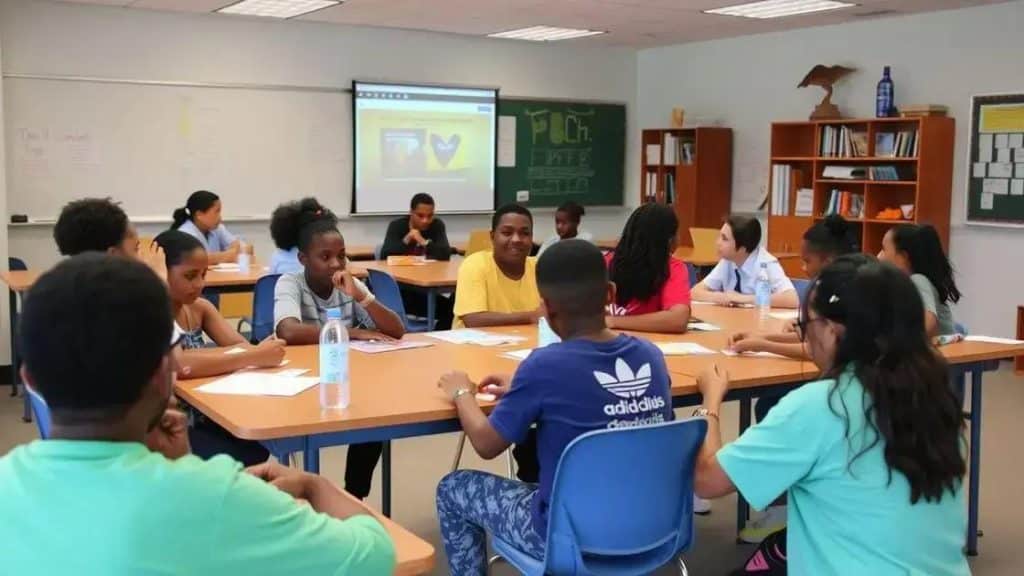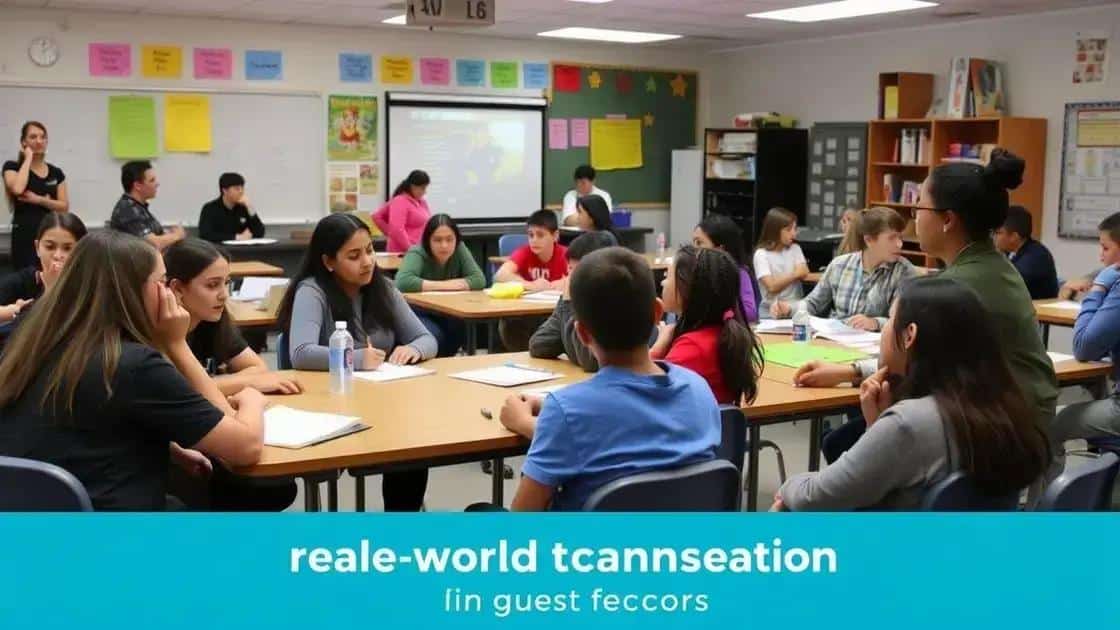Four curriculum improvement ideas to boost engagement

Continuous feedback and assessment strategies enhance student learning by fostering ongoing dialogue, providing timely insights, and encouraging collaborative environments, thus tailoring education to individual needs.
Four curriculum improvement ideas are essential for educators looking to enhance student engagement and success. Have you ever wondered how small changes can make a big difference in a classroom? Let’s explore some innovative strategies.
Engaging students through active learning
Engaging students through active learning is essential for creating a dynamic classroom environment. This approach empowers learners to take charge of their education by participating in hands-on activities. It encourages collaboration and critical thinking, making the learning experience more meaningful.
Benefits of Active Learning
Active learning fosters a deeper understanding of the material. Students are more likely to remember concepts when they actively engage with them. This leads to improved retention and a greater appreciation for the subject matter. Below are some specific benefits:
- Enhances critical thinking skills
- Boosts student motivation and interest
- Promotes collaboration through group work
- Encourages immediate feedback and peer assessment
Incorporating active learning strategies can significantly transform the classroom experience. For instance, project-based learning allows students to explore real-world problems, applying their knowledge in practical ways. This not only increases understanding but also prepares them for future challenges. Another effective method is using simulations, where students can experiment and see the direct outcomes of their decisions.
Techniques to Implement Active Learning
Educators can utilize various techniques to promote active learning effectively. Some engaging methods include:
- Group discussions and debates
- Hands-on experiments and demonstrations
- Interactive technology such as quizzes and games
- Problem-solving exercises that require collaboration
Ultimately, active learning strategies create an inclusive atmosphere where every student feels valued. When students are encouraged to share their thoughts and ideas, it leads to a richer classroom experience. This not only enhances learning outcomes but also builds essential life skills.
Integrating technology into the curriculum
Integrating technology into the curriculum is an essential practice for modern educators. This approach enhances learning experiences and prepares students for a tech-driven world. By blending traditional teaching methods with innovative technologies, educators can create a more dynamic and engaging classroom environment.
Why Technology Matters
Utilizing technology in the classroom helps meet diverse learning needs. It allows students to access information quickly and encourages them to explore topics in-depth. Moreover, technology fosters collaboration among students, enabling them to work together on projects, share ideas, and improve their communication skills.
- Expands resources for research and learning
- Facilitates personalized learning experiences
- Enhances student engagement through interactive tools
- Prepares students for future careers
As technology continually evolves, its integration into education becomes even more important. One effective way to integrate technology is through online collaboration platforms. These tools allow students to contribute to group projects from anywhere, fostering teamwork and creativity. Another way is to incorporate educational apps that make learning enjoyable while reinforcing concepts taught in class.
Strategies for Successful Integration
To successfully integrate technology, educators should adopt specific strategies. First, they need to assess their curriculum and determine where technology can be most beneficial. Second, providing professional development for teachers ensures they are comfortable using new tools. Finally, ongoing support and resources are essential for both teachers and students.
- Evaluate classroom needs and technology options
- Invest in teacher training and support
- Encourage feedback from students on technology use
- Continuously update technology resources
By incorporating technology thoughtfully, educators can enhance learning outcomes and prepare students for success in a quickly changing world. It’s about creating an environment where technology and education mesh seamlessly, supporting each student’s journey toward knowledge and understanding.
Importance of real-world connections

The importance of real-world connections in education cannot be overlooked. When students relate their learning to real-life experiences, they tend to grasp concepts more readily. Making these connections helps reinforce the relevance of what they are studying, allowing them to see its impact on their lives and future careers.
Benefits of Real-World Learning
Incorporating real-world connections into the curriculum provides numerous benefits. It not only enriches students’ understanding but also engages them in ways that traditional teaching methods may not. Here are a few key benefits:
- Increases student motivation and interest
- Enhances critical thinking and problem-solving skills
- Encourages community involvement and service
- Builds essential life skills through practical application
Connecting classroom lessons to the community fosters a sense of belonging and responsibility among students. For instance, projects that involve local businesses or environmental issues create meaningful learning experiences. Students can tackle real challenges, which heightens their engagement and passion for the subject.
How to Create Real-World Connections
Teachers can effectively integrate real-world scenarios by using various strategies. One approach is to invite guest speakers who share their expertise and experiences in relevant fields. Moreover, organizing field trips allows students to explore practical applications of their studies outside the classroom environment.
- Utilize case studies related to industry practices
- Collaborate with local organizations for hands-on projects
- Encourage student-led initiatives addressing community needs
- Integrate technology to connect with global experts
By integrating real-world connections, educators can create a rich learning environment. This approach ensures students see the bigger picture and better understand how their education prepares them for the future. Ultimately, bridging classroom knowledge with real-life application cultivates a more engaged and informed generation.
Promoting collaborative learning environments
Promoting collaborative learning environments is crucial in modern education. When students work together, they not only share knowledge but also develop important social skills. In a collaborative setting, learners engage with diverse perspectives, fostering deeper understanding and critical thinking.
Benefits of Collaborative Learning
There are many advantages to collaborative learning. Students enhance their communication skills as they discuss ideas and tackle problems together. Working in groups encourages accountability, leading to increased motivation among peers. Here are some key benefits:
- Enhances problem-solving abilities
- Builds strong interpersonal skills
- Encourages active participation
- Fosters a sense of community and belonging
Creating a collaborative environment requires thoughtful planning. Teachers can implement group projects that allow students to explore subjects in greater detail. For example, creating presentations or developing a shared project encourages teamwork. By assigning roles within the group, each student can contribute their strengths while learning from others.
Strategies for Encouraging Collaboration
To establish a successful collaborative learning environment, educators should consider specific strategies. One effective approach is to use technology tools that facilitate communication and sharing. Online platforms allow students to collaborate on projects from different locations, widening access to diverse resources.
- Incorporate group discussions in lessons
- Use technology to create collaborative spaces
- Assign group tasks that require joint effort
- Encourage peer feedback and evaluation
Additionally, promoting a culture of respect and support is essential. When students feel safe to express their opinions, collaboration becomes more meaningful. By emphasizing teamwork and collective learning, teachers can create an engaging educational experience that prepares students for future teamwork in their careers and lives.
Continuous feedback and assessment strategies
Continuous feedback and assessment strategies are vital for improving student learning. These strategies create an ongoing dialogue between students and teachers, enabling adjustments to be made as needed. Continuous assessment goes beyond traditional tests, focusing on student growth and understanding throughout the learning process.
The Importance of Feedback
Feedback is essential in guiding students towards their goals. It helps them identify their strengths and areas for improvement. When students receive timely and specific feedback, they are more likely to make necessary changes to enhance their performance. This support fosters a growth mindset where learners see challenges as opportunities.
- Encourages self-reflection and critical thinking
- Helps tailor learning to individual student needs
- Fosters motivation and engagement in the learning process
- Provides a clearer pathway to academic success
Incorporating regular check-ins allows teachers to assess understanding before high-stakes evaluations. Techniques such as quick quizzes, polls, or reflection journals can provide valuable insights into student progress. These methods help educators adjust their teaching styles to meet the needs of all learners.
Effective Assessment Strategies
To create an effective feedback loop, teachers should employ various assessment strategies throughout the learning process. Formative assessment plays a crucial role, as it focuses on monitoring student progress in real-time. Here are several effective strategies:
- Utilize peer assessments to encourage collaboration
- Incorporate digital tools for instant feedback
- Provide opportunities for self-assessment and reflection
- Use rubrics to clarify expectations
Continuous feedback and assessment not only enhance learning but also build confidence in students. By creating a supportive environment where feedback is a regular part of the process, educators empower students to take charge of their learning journey. This proactive approach leads to improved outcomes and a more engaged classroom atmosphere.
FAQ – Frequently Asked Questions about Continuous Feedback and Assessment Strategies
What is continuous feedback in education?
Continuous feedback is an ongoing dialogue between teachers and students to enhance learning. It helps students understand their strengths and areas for improvement.
Why is collaborative learning important?
Collaborative learning fosters teamwork, encourages diverse perspectives, and helps students develop essential communication skills.
How can assessments be used effectively?
Assessments can be effective when they are varied and frequent, allowing teachers to monitor student progress in real-time and adjust their teaching accordingly.
What are some strategies for providing effective feedback?
Effective feedback strategies include using rubrics, peer assessments, and self-assessments to ensure that students understand expectations and learn from their experiences.





